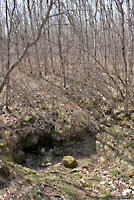
Yellow = T. s. parietalis
Click map to enlarge and see key to other subspecies
|
 |
 |
 |
 |
 |
| |
Adult, Manitoba, Canada |
|
Lght scales are on the second and third scale rows above the ventral scales. |
 |
 |
 |
 |
| |
Adult, Manitoba, Canada |
|
Adult, Manitoba, Canada |
 |
 |
 |
 |
Adult, Manitoba, Canada. Red-sided Gartersnakes from the northern part of their range do not show very much red coloration.
|
Adult, Manitoba, Canada |
 |
 |
 |
 |
| Adult, Manitoba, Canada |
Adult, Manitoba, Canada |
Adult, Manitoba, Canada |
 |
|
|
|
Juvenile, 5,800 ft.
Missoula County, Montana, |
|
|
|
| |
| Habitat |
 |
 |
 |
 |
Habitat, Narcisse Snake Dens,
Manitoba, Canada |
Habitat, Narcisse Snake Dens,
Manitoba, Canada |
An adult snake was seen on the road near this marsh a short distance north of the Narcisse snake dens, Manitoba, Canada. It is probably typical of the summer feeding habitat. |
Habitat, Manitoba, Canada |
| |
| Spring Emergence at the Narcisse Snake Dens |
 |
Thamnophis sirtalis, the Common Gartersnake, occurs farther north than any other species of snake in North America. The Red-sided Gartersnake occurs farther north than any other subspecies of Common Gartersnake. Common Gartersnakes have a very long activity season and the coldest temperature tolerance of any other species of North American snake. Overwintering takes place underground below the frost line in any sort of burrow or hole. Red-sided Gartersnakes are well-known for the large numbers that share underground dens in the Interlake region of Manitoba, Canada. A site at Narcisse with 4 large dens has been developed into a world-renown viewing site.
The Red-sided Gartersnakes in Narcisse, Manitoba, Canada, emerge from their hibernation dens in late April or early May. They breed at the dens for a short period, then disperse into the surrounding countryside. A study1 showed that Manitoba snakes moved from 4.3 - 17.7 km to their summer feeding grounds.
An average of 10 - 15 offspring4 are born live between the end of July and late September. Larger females give birth to more babies. Adult snakes that survive the summer return to the area of the dens in late August and September. Adult snakes find their way back to the dens following the accumulated scent trails of snakes that returned before them. However, the method used by these first snakes to return to the dens is still a mystery.
Newborn snakes spend their first winter hibernating on their summer range. They don't go to the dens until after their second summer.
Life at a high northern latitude is difficult for snakes who maintain their body temperature using the temperature of their surroundings. A study in Manitoba2 found that from 33 to 50 percent of all snakes died during winter hibernation. Yearling snakes were found to have a survival rate of near 51%, while only an estimated 34% of adults survive.3 Crows, owls, ravens, magpies, hawks, kestrels, foxes, coyotes, bears, weasels, mink, racoons, ground squirrels, and skunks are some of the animals that prey on Red-sided Gartersnakes.
|
| |
1 Gregory and Stewart, 1975.
2 Gregory, P. T. 1977a Life history observations of three species of snakes in Manitoba. Canada Field-Natur. 91:19-27
3 Gregory, P. T. 1977b Life-history parameters of the red-sided garter snake (Thamnophis sirtalis parietalis) in an extreme environment, the Interlake region of Manitoba. Natural Museum of Canada Publ.Zool. 13:1-44
4 Rossman, Douglas A., Neil B, Ford, & Richard A. Siegel. The Garter Snakes - Evolution and Ecology. University of Oklahoma press, 1996.
[13 - 26 offspring according to the informational sign at the Narcisse Snake Dens.]
|
| |
 |
Click the sign above for more photos and information about the annual celebration of gartersnake emergence in spring at the Narcisse Snake Dens.
|
 |
 |
 |
 |
| Narcisse Den 1 |
Narcisse Den 2 |
Narcisse Den 3 |
Narcisse Den 4 |
 |
 |
 |
 |
 |
 |
 |
 |
 |
 |
 |
 |
 |
 |
 |
 |
| |
| Short Videos |
 |
 |
 |
 |
Thousands of Red-sided Gartersnakes recently-emerged from hibernation, wrestle for
breeding opportunities down in the Narcisse snake dens in Manitoba, Canada. |
A mating ball of Red-sided Gartersnakes flows down the hill. |
 |
 |
 |
 |
| A female Red-sided Gartersnake is pursued by several males. |
A Red-sided Gartersnake mating ball in one of the Narcisse snake dens. |
A Red-sided Gartersnake mating ball in one of the Narcisse snake dens. |
A Red-sided Gartersnake leaves the dens and runs into a fence put up to divert the gartersnakes into tunnels under the highway so they don't crawl over the road where they might get crushed by traffic. We see it crawl along the fence until it finds the tunnel and crawls inside. |
|























































